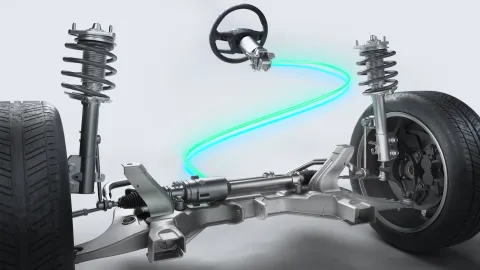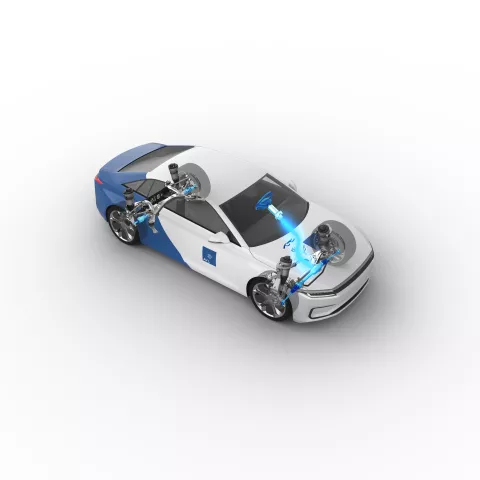Integrating an innovative steering system into an existing vehicle architecture is a complex challenge that demands extensive expertise and new safety concepts.

Permanent Focus on the Overall System
Successful development starts at the level of the overall vehicle. A top-down approach is essential for ensuring that all components work together harmoniously. If development starts at software level, you run the risk of losing sight of the overall system.
Functional Safety (FS)
What happens if components of a Steer-by-Wire system fail?
How can I ensure the steering still functions? These questions are central to developing a functional safety concept and designing a redundant steering system.
Complex Electronics and Software
Flawless functioning of the steering system requires thorough validation of software, components, and the integrated network. This process is time-consuming and requires in-depth system knowledge to ensure maximum reliability.
Optimal Steering Feel
How can a natural steering feel be created for Steer-by-Wire systems despite the lack of a mechanical connection? The answer lies in functions that provide drivers with precise feedback on wheel movements and forces.
These functions are the result of extensive development and need to be designed, tested, and calibrated to achieve the desired effect.

Our benchmarking data is the basis for developing the optimal steering feel. We analyze existing vehicles and steering systems to record the desired parameters and develop your system with a clear focus on these targets.
First, we define test cases in which a good steering feel is noticeable. Using state-of-the-art equipment, we perform the specified driving maneuvers, gather extensive data, and create a precise steering reference model.
This theoretical model simulates various characteristics across the entire steering system and provides crucial inputs for our systems engineering. The software model reflects all relevant parameters, such as friction and damping, enabling for a high level of maturity early in the development process.
In our functional architecture concept, we determine the required functions and the related system layout to achieve the optimal target function.
Our continuous methodology and systems engineering approach makes development more efficient, faster, and more economical.
Targeted Frontloading
Utilizing the latest, virtual development tools combined with our continuous methodology allows you to make informed decisions early on and reduce development time.
Very High Level of Maturity
We achieve a very high level of maturity in the virtual development phase. This enables us to develop functionalities and accompanying safety concepts in a safe environment without hardware prototypes.
Driver-in-the-Loop: Focus on the Driver
To validate the steering system as early on as possible, we use three different driving simulators. This environment enables the steering feel to be optimized and the software to be pre-calibrated for future integration, which saves development time.
Objectification of Steering Feel with AVL-DRIVETM
Our proven development tool, AVL-DRIVE™, provides a precise and objective assessment of steering feel, both in real-world and virtual environments. This enables us to consistently monitor the desired steering and driving characteristics, set specific development and improvement targets, and validate them effectively.
Steering Reference Model
The physical steering model generated using AVL-DRIVETM enables us to precisely determine the target steering characteristics of your steering system and serves as a basis for using systems engineering for efficient system development.
Customizable Whitebox-Software
We also offer whitebox-software on request. You have the option of refining and modifying this software in collaboration with us or independently.
Systems Engineering Without a Physical Prototype
Our Driver-in-the-Loop (DiL) approach enables precise development of your steering system according to standard specifications, using a driving simulator in place of a physical vehicle. Individual components are tested on a dedicated Hardware-in-the-Loop (HiL) testbed. This allows us to virtually replicate the entire vehicle and optimize existing systems – whether at the component level or within the software.
Innovative Function Development
Benefit from our expert knowledge to develop new functions based on an existing system. We help you to achieve your targets at vehicle level and maximize functionality.
Comprehensive FuSa-Services
Functional safety – simple, secure, and results-driven: Our services cover every aspect of functional safety, from conceptual and series development to system and vehicle validation.
Concept development
- Analysis of hazards and risks (ASIL classification)
- Failure mode and effect analysis, fault tree analysis
- Prototype safety concepts
- Development of functional safety concepts
- Simulation-based construction support
- Safety/supplier management
Systems engineering
- Technical safety concept
- Modeling, draft, and pre-calibration of safety mechanisms
Safety tests
- Test planning/management
- Analysis of fleet data
Holistic Steering Development
We design overall systems built from individual hardware and software components. At AVL, our function-based development approach focuses on defining precise functions and deriving accurate software for the components of a Steer-by-Wire system. This ensures a comprehensive and integrated development process, optimizing both performance and functionality.
